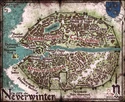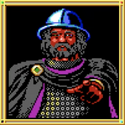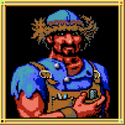Neverwinter, also known as the City of Skilled Hands and the Jewel of the North, was a bustling, cultured, and cosmopolitan city-state in northwest Faerûn.[1][2][3][4][5][20] Neverwinter was regarded by Volo as the most cosmopolitan and civilized city in all of Faerûn. The city was a member in good standing of the Lords' Alliance.[18] Known for its craftsfolk and gardeners, the city's multi-colored-glass lamps, precision water clocks, exquisite jewelry, and magnificent gardens ensured the warm winters were colorful and the summers were rich with fresh fruit.[1][2][3][21]
Etymology[]
The city was originally named Eigersstor, which was an Illuskan word. The name "Neverwinter" was the Chondathan translation.[6][22][note 1]
A number of legends explained where the city's name came from, but they contradicted each other. Some believed the city was founded by a sun elf named Halueth Never, who led the elves of Iliyanbruen against an Illuskan invasion in −10 DR. Surrounded by enemies, he chose the site where the river met the sea to make his last stand, naming the place "Never's Winter", believing he would die in the ensuing battle. However, human allies arrived just in time and together they defeated the Illuskans. Never founded the city, keeping the name, and over the years it was shortened to "Neverwinter".[23]
Others, such as Volo and Elminster, reported the name came from its gardens, for Neverwinter's gardeners were acclaimed throughout the Realms for keeping their gardens growing and flowers blooming even through winter snow. This was also the source of the city's moniker, "the City of Skilled Hands".[1][2][3][4] (In fact, they used hothouses.[3])
Others, however, believed the city was named for its unusually warm climate and how its harbor remained ice-free in the winters.[2][3]
Geography[]
Neverwinter stood on the northern Sword Coast, on the High Road between Waterdeep and Luskan, specifically between Leilon and Port Llast.[1][2][4] To the east lay the Neverwinter Wood and, at its heart, the volcanic Mount Hotenow. The Neverwinter River was heated by fire elementals living under the volcano before flowing through the forest and the city. It carried its supernatural warmth with it, keeping the river and harbor from freezing up in winter and the gardens green year-round.[2][3][5] The heat given off by the river created a permanent warm climate in the immediate area.[7]
Southeast of Neverwinter stood the monastery of Helm's Hold.[2]
History[]
Brief History[]
The first settlement in the Savage Frontier was an elven city known as Illefarn, a bustling nation after the time of the Crown Wars. Eventually, Illefarn was divided into three nations, of which Iliyanbruen was the most prominent.[24] Iliyanbruen was weakened by orc invasions, which paved the way for Eigersstor, the first multi-racial settlement in the area, which would later be called Neverwinter.[25]
Neverwinter became a center of civilization, peace, and culture and was widely viewed as a marvel by visitors. This trend lasted, seemingly unbroken since its founding[26] until the Year of Wild Magic, 1372 DR when a disease known as the Wailing Death laid low most of the city's inhabitants.[27] Then, in the Year of Blue Fire, 1385 DR, the Spellplague struck both Neverwinter and all of Faerûn.[28]
The century that followed saw the rise in power of a new Netheril. Netherese loyalists infiltrated the power structure of the weakened Neverwinter,[26] but their efforts were sidetracked by the eruption of Mount Hotenow in the Year of Knowledge Unearthed, 1451 DR, laying the city to waste and killing the ruling Alagondar family.[7]
In the Year of Splendors Burning, 1469 DR,[29] Lord Dagult Neverember, seeing an opportunity to add to his financial empire, hired workers to help rebuild the city and Mintarn mercenaries to protect it from monsters and bandits. Claiming to be a descendant of Neverwinter's former rulers and thus the rightful "Lord Protector" of the city, Dagult started the New Neverwinter movement. Lord Neverember invested a great deal of his own fortune to rebuild the city's infrastructure, buy the interest of merchants to send their caravans again to Neverwinter, and even ensure Neverwintan refugees had enough food and gold in hand.[30] By 1491 DR, Neverember's efforts to rebuild the city proved successful, and Neverwinter had slowly been restored as a center of civilization in the Sword Coast North.[31]
Symbol[]
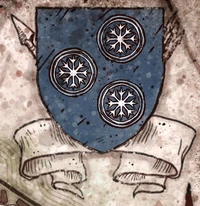
The emblem of Neverwinter.
Circa 1357 DR, the badge of Neverwinter was three white snowflakes of different shapes contained in silver and blue halos. These were arranged vertically as if falling and offset so they pointed to the right. They were linked by a white swirl.[2][3]
Government[]
By 1357 DR, the city was ruled fairly and justly by Lord Nasher Alagondar, an ageing, veteran adventurer and devout worshiper of Tyr.[2][3][4][32][5][7] As such, the Neverwintans followed a Tyrran faith that promoted justice and fairness, with greed frowned upon. Lord Nasher ensured the city was well defended, both physically and magically, against attacks or infiltration from Luskan, Neverwinter's warlike rival. It was forbidden to make maps of the city as part of an effort to thwart Luskan spies.[18]
While Lord Nasher was the nominal leader, the real power in the city was held by the Many-Starred Cloak, an order of good-aligned wizards that supported the rule of Lord Nasher.[32]
Lord Nasher rejected the position of King of Neverwinter for much of his life, only in old age accepting the title by public acclamation.[7] After his death, he was succeeded by his son Bann Alagondar,[17] who founded the Alagondar royal family. The Alagondar kings and queens ruled justly and kept Neverwinter stable and prosperous even in the dark period after the Spellplague, until the destruction of Neverwinter in the Mount Hotenow eruption, when all members of the family were slain.[7]
New Neverwinter[]
As part of his bid to create a mercantile empire in Neverwinter, Dagult Neverember created the title of "Lord Protector of Neverwinter" for himself in 1467 DR. However, it was questioned whether Dagult was the rightful ruler, as many factions vied for Neverwinter and the citizens were divided in loyalties.[7] As he had to fulfill his obligations being also Open Lord of Waterdeep, Lord Neverember left the day-to-day running of the city to General Sabine and Mayor Soman Galt.[10]
In the Year of the Warrior Princess, 1489 DR, Lord Neverember was exiled from Waterdeep and replaced as Open Lord by Laeral Silverhand.[33] Afterward, Neverember focused all his attention on Neverwinter. Due to his commitment and help given to Neverwinter, the Neverwintans finally accepted Lord Neverember as their rightful leader.[31] But bitter over being exiled from Waterdeep, Neverember became more despotic and enforced heavy-handed laws. He levied heavy taxes to noble families living in Neverwinter, preventing them from gaining significant power, while enacting harsh laws that prohibited the formation of new guilds and limited the power of existing ones.[34]
Relations[]
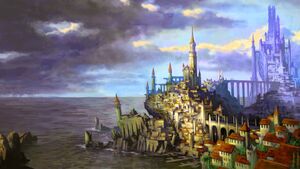
Neverwinter seen from afar, as of 1479 DR.
Typically Neverwinter of the mid-1300s preferred to avoid conflict and controversy and instead do business briskly but quietly via its merchants, while its armies stayed home. They waited for their Luskan and orc foes to come to them.[2]
Neverwinter was a member of the Lords' Alliance since before 1356 DR.[35][36][37] It invariably sided with Waterdeep and stood against Luskan and the orcs of the region.[5]
Circa 1357 DR, a triumvirate of merchants from Neverwinter, Waterdeep, and Mirabar led the mining city of Fireshear, to ensure no one city could seize control of it.[38][39] Neighboring Port Llast was a close ally and 50 Neverwintan soldiers guarded it.[3]
Defenses[]
Since at least the mid-1300s DR, Neverwinter had a standing army, the Graycloaks,[2][40] In the mid-to-late 1300s DR, they were composed of 400 archers and spearmen, who served as a city guard at the walls and harbor, operated as a police force, and patrolled the High Road from Port Llast to Leilon.[2][3][18] At any one time in peacetime, sixty were on duty, sixty were on leave, and sixty were in training. Much like their city, they had a reputation for quiet efficiency and professionalism.[2]
If the city's walls were threatened by orcs or Luskan forces, the defenders could catapult explosive missiles down on the attackers, often slaughtering and routing them. Both missiles and the specially designed catapults were devised by the best 'skilled hands' of the city, its craftsfolk and wizards.[2][3][18] These explosive missiles could also be used as grenades by the soldiers. They were not for sale and their manufacture was a state secret, but many groups desired them.[3]
The city also had its own navy.[41]
In desperate situations, Lord Nasher could call upon the wizards of the order of the Many-Starred Cloak for help.[18] Lord Nasher's personal bodyguard were the well-equipped warriors of the Neverwinter Nine.[2][3][4]
As of 1479 DR, the standing army were the Neverwinter Guard,[16] which was composed mostly of the Mintarn mercenaries hired by Lord Neverember. A few independent militia forces assembled by the citizens helped to protect the city in times of need. Lord Neverember also hired adventuring bands to deal with threats to the city that the Mintarn mercenaries could not handle.[7]
With the city rebuilding in the late 1480s DR, a city watch known as the Wintershield watchmen was introduced, comprised mostly of locals rather than mercenaries, and the Neverwinter Guard became a dedicated military.[42][43] Many of the Sons of Alagondar volunteered to serve in the Neverwinter Guard, causing Lord Neverember to depend less on the mercenaries' services. Lord Neverember still hired adventurers and mercenaries to help protect Neverwinter and train local troops rather than accept the help of the armies of the Masked Lords of Waterdeep, whom he felt had betrayed him.[31]
Law & Order[]
Neverwinter had only a small thieves' guild by 1358 DR.[44]
Society[]
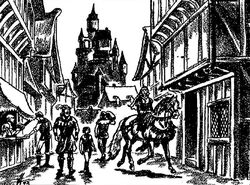
A street scene in Neverwinter in the 1360s DR.
Through the mid-to-late 1300s, Neverwinter was known as a friendly,[1][4] charming, cosmopolitan, and cultured city, without being quaint, arrogant, or grasping.[5][18] They displayed good but quiet manners and liked a job done well, with efficiency and dedication.[3] Even merchants from Amn and Calimshan, who had a poor opinion of the cities of the North, considered Neverwinter to be a civilized place. The Neverwintans avoided conflict and controversy, and were considered to be quiet, mannered, literate, efficient, and hard-working folk, who had great respect for deadlines as well as for the property and happiness of others. They believed in "following one's weird", as they put it, a term for whatever odd or even reckless pursuit one took to make them happy.[18] Amid all the weird-following tolerance and variety in the city, there was a great respect for peacefulness, law, and order.[21]
The wealthy circles of Neverwinter were avid readers of Neverwinter Nights and similar periodical chapbooks that collected news, art reviews, musician visit information, reviews of various performances, and, of course, a healthy amount of gossip. Over the course of history, many chapbooks were regularly printed, with some of them existing for decades, while others disappeared under pressure from nobles or the general public.[45]
After the foundation of the Alagondar royal family in the late years of the 14th century DR, the Neverwintans became a very patriotic people, proud of their leaders and their city.[7]
After the destruction of the city in 1451 DR, the Neverwintans showed a new facet: stubbornness and determination. Many survivors remained in the city, and ever since had demonstrated the resolution to rebuild Neverwinter to its former glory and to defend her from many dangers, both mortal and extraplanar alike.[7]
Religion[]
The main faiths in 14th-century Neverwinter were those of Helm, Oghma, and Tyr. The temples of the Hall of Justice and House of Knowledge catered to the faithful of Tyr and Oghma, respectively, while those of Helm congregated in nearby Helm's Hold.[4][13] Shortly after 1374 DR, the Temple of Waukeen was built in Neverwinter to aid in region's mercantile recovery by a personal invitation from Lord Nasher Alagondar.[46]
With the deaths of Helm and Tyr in the year before the Spellplague, their faiths were replaced by those of Torm and his subordinate deity Bahamut,[12][14] as well as the faith of Selûne, as her followers wanted to bring hope to the peoples of Neverwinter.[15] By 1479 DR, the faith of Asmodeus had become popular as well, and the ashmadai had great influence in the city's politics.[11] Kelemvor's faithful also had a strong presence in the city since before 1479 DR, and members of this faith were focused on cleansing Neverdeath of undead and other evil forces.[16]
The Neverwintans never stopped revering Tyr, however, despite his death.[12] When the god returned to life after the Second Sundering, his faith was quickly accepted again, becoming as popular as it was before.[31][34]
In the late 15th century, as Neverwinter slowly restored itself as a cosmopolitan city, temples of many faiths became common in all districts of the city.[31]
Trade & Business[]
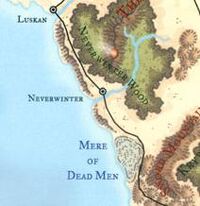
Map of Neverwinter on the Sword Coast North.
In the mid-to-late 1300s DR, Neverwinter controlled much of the mining trade from dwarf and gnome outposts in the nearby Underdark via hidden ways in various warehouses in the city. It also had a large fishing economy and did good trade in logging from the Neverwinter Wood.[21] Neverwinter traded mostly via the merchants of the nearby city of Waterdeep.[1][4][13] The city was famed for its accurate water-clocks, lamps made with multi-colored glass, fine jewelry, which were found across Faerûn.[1][2][4][5] The gardeners raised plants in hothouses to grow them even in winter.[3] The gardens supplied fruits to the city's markets.[2][5] During the late 14th century DR, three trade cartels were operating out of Neverwinter's Temple of Waukeen: the Circle of Friends, the Forgotten Lords, and the Fated Winds, rumored to have Black Network connection. After the Shadow War, the Red Wizards were allowed to open a Thayan enclave to boost the hurting post-war economy.[46]
However, Neverwinter's true asset was its importance as a center of craftwork, learning, and magical innovation.[21] Merchants and crafters usually practiced their works in buildings dedicated to such tasks. Street vendors were rarely seen in Neverwinter.[13]
With the destruction of Neverwinter in 1451 DR, trade came to a total halt in the region.[7]
After 1461 DR, as part of the rebuilding efforts, Lord Neverember focused much of his resources on reestablishing trade and contracting crafters to help restore the city's infrastructure.[10] Merchants from the "new" continent of Laerakond began to trade with the Faerûnian cities on the Sword Coast some years before 1479 DR. In Neverwinter, a group of traders from Tarmalune, one of the Windrise Ports of Laerakond, approached Lord Neverember in hopes of establishing permanent trade routes between the two continents.[47]
Around 1491 DR, Neverwinter was a city full of opportunities. As word spread that Neverwinter was being restored, merchants from both the north and the south became interested in trading with the city once again. Likewise, Lord Neverember began forging a trading alliance with the restored Gauntlgrym in hopes of increasing the prosperity of both cities while ensuring his advantage over the nobles and merchants from Waterdeep and Baldur's Gate.[48]
Without guilds to restrict trade or construction, those who wanted to start a business in Neverwinter could simply do so, and those traders who dealt with basic products, such as foodstuffs, became wealthy just by selling their goods in the city. Likewise, there was demand for many jobs and those who offered their services either as workers or as apprentices had plenty of options despite the high competition.[48]
Layout[]
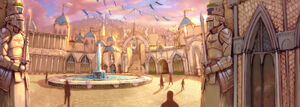
Neverwinter in the afternoon.
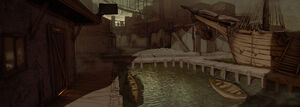
Neverwinter at dusk.
Before the Mount Hotenow eruption, Neverwinter was a picturesque city and boasted such sights and edifices that would be noteworthy in other cities, but were fairly common features in the Jewel of the North.[21]
The city's layout was roughly the shape of an eye, with the Neverwinter River as a long axis running roughly east–west. At one end was the harbor and at the other was the Upland Rise, and beyond that the Neverwinter Wood. Four gates penetrated its walls, in the northwestern, northeastern, southwestern, and southeastern corners.[21]
Among its most prominent landmarks were its three spectacular, intricately carved bridges: the Dolphin, the Winged Wyvern, and the Sleeping Dragon, considered the city's emblems by its inhabitants. Under these, the Neverwinter River cascaded over small, gentle waterfalls as they coursed into the city's bustling harbor. [5][21]
The city was full of beautiful and ingeniously designed buildings with many famous in their own right, such as the House of Knowledge, Neverwinter's tall and many-windowed temple of Oghma; the Hall of Justice, the temple of Tyr and the public office for the rulers of the city; and Castle Never, the castle of the ruler of Neverwinter. In addition, the reputations of such unique taverns as the Moonstone Mask, the Shining Serpent Inn, and the Fallen Tower reached far beyond the city's walls and further added to the city's distinction.[21]
After the Ruining, the city was almost entirely destroyed. Of the three bridges, only the Winged Wyvern remained functional.[20] Much of the southeastern quadrant collapsed into a yawning pit, known as the Chasm, which continually spawned plaguechanged horrors. Many former edifices and homes became martial garrisons to keep the monsters at bay.[7]
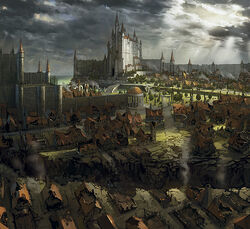
Neverwinter in ruins, around 1479 DR.
Neverwinter remained in ruins for almost two decades but, thanks to Lord Neverember's efforts, the city began to regain its former glory by the late 1480s DR.[10] Inns like the Driftwood Tavern and the Beached Leviathan became popular across the Sword Coast.[49]
The Chasm was magically sealed around 1484 DR,[31] although at such cost to the city's coffers that some of its outer walls still lay in ruins and several of its neighborhoods remained abandoned and plagued by monsters and brigands by 1491 DR.[34][50]
Locations[]
As of 1372 DR, Neverwinter was divided into the following districts:
- The City Core, the central region of the city, where the ruling offices and main temples were located.[51]
- The Peninsula District, which comprised the southwestern quadrant of the city.[51]
- The Docks District, the main port.[51]
- The Blacklake District, located in the northeastern quadrant.[51]
- The Beggar's Nest, located in the southeast quadrant.[51]
- The Arcanist Quarter, located in the southeast quadrant.[16]
After the war with Luskan, some parts of the city were rebuilt, and the city's layout changed:
- The Merchant Quarter, located at the center of the city, and built over the remains of the City Core and the Peninsula District.[23]
- The Blacklake and Docks Districts survived the war with Luskan almost unscathed.[23]
After the Mount Hotenow eruption in 1451 DR, the city was almost destroyed. After the rebuilding project, the layout was drastically changed:
- The Protector's Enclave, located where the City Core, the Peninsula District, and the Merchant Quarter once stood.[52][31]
- The Blacklake District was now the northwestern section of the city.[52][31]
- The Docks District became part of the Protector's Enclave to the south, and the Blacklake District to the north.[52][31]
- The Neverdeath Graveyard was built as the main graveyard of the city.[52]
- The Arcanist Quarter and the Beggar's Nest were completely destroyed, being replaced by the Chasm.[52][note 2] The Chasm was sealed around 1485 DR.[31][34]
- The River District, also known as the Towers District, located at the northeastern portion of the city.[52][16]
Inhabitants[]

A Neveren tax collector.
As of 1370 DR, Neverwinter was inhabited mostly by humans, half-elves, and a minority of dwarves.[13] They occupied a small dwarf quarter.[53]
As of 1479 DR, the city was more cosmopolitan, with members of many races living alongside the common human and half-elven families. The rare eladrin[54] and even tieflings were common sights among the citizens.[16] A sizable delegation of dragonborn mercenaries had been hired by Lord Neverember alongside the Mintarn ones.[10][16] The River District was invaded by a tribe of orcs from Many-Arrows,[55] and although most left when they were recalled by their compatriots in the north, around 1484 DR,[31] a few orcs and half-orcs were still living in Neverwinter as of 1491 DR.[16]
Organizations[]
Many of the organizations that operated in Neverwinter took on more prominent roles by 1479 DR.[56] As of 1491 DR, many of these factions still vied for control of the city.[50] Among the most important were:
- The Covenant, an order of wizards that operated out of Neverwinter during its earlier years.[26]
- The Many-Starred Cloak, an order of wizards that supported the rule of Lord Nasher Alagondar in the 1370s DR.[32]
- The Graycloaks militia that protected Neverwinter during the rule of Lord Nasher Alagondar.[18]
- A cell of the Harpers that operated in Neverwinter in the 1360s DR.[18]
- The New Neverwinter movement started by Lord Neverember in 1461 DR.[10]
- The Neverwinter Guard, the army of Neverwinter in the late years of the 15th century.[16]
- The Wintershield Watchmen, the police force of Neverwinter in the late years of the 15th century DR.[42][43]
- The dreaded Abolethic Sovereignty, which pulled the strings from behind the scenes since the eruption of Mount Hotenow.[29]
- The Ashmadai, who gained great renown in Neverwinter in the late 15th century.[11]
- A Thayan cell under Valindra Shadowmantle, operating in Neverwinter in the late 15th century to advance Szass Tam's agenda in the region.[57]
- The Dead Rats of Luskan, who had gained a foothold in Neverwinter in the late 15th century.[58]
- The Sons of Alagondar insurgent movement that opposed Neverember's rule,[59] but was mostly disbanded by 1491 DR.[31]
- A cell of Bregan D'aerthe, under the direct leadership of Jarlaxle Baenre himself.[60]
- A cell of the Order of the Gauntlet that became prominent in Neverwinter around 1491 DR.[34]
Before their utter defeat in the late 15th century,[31] a cell of Shadovar agents[61] and a tribe of orcs from Many-Arrows also operated in the city.[55]
Trivia[]
- Neverwinter was the origin of the phrase "By the clocks of Neverwinter", used to swear something to be completely true and honest, declare something to be precise and accurate, or to complain something was needlessly perfectionist and pedantic. This was of course a reference to the precision of its timepieces.[1][4][18][62]
- The Neverwinter knife owed its name to the city.[18]
- Neverwinter's broadsheet was named Neverwinter Nights.[63]
Appendix[]
Notes[]
- ↑ While most sources spell the name Eigersstor, Races of Faerûn spells it Eiggerstor.
- ↑ Estimated from the maps.
Appearances[]
- Adventures
- Vecna: Nest of the Eldritch Eye
- Novels
- Gauntlgrym • Neverwinter • Charon's Claw • The Last Threshold • Brimstone Angels
- Video Games
- Neverwinter Nights (AOL game) • Neverwinter Nights series (Neverwinter Nights • Neverwinter Nights 2) • Dungeons & Dragons: Heroes of Neverwinter • Dungeons and Dragons: Neverwinter
- Referenced only
- Baldur's Gate • Neverwinter Nights: Darkness over Daggerford • Baldur's Gate III
- Board Games
- Dungeons & Dragons Adventure Begins • Dungeons & Dragons: Bedlam in Neverwinter
- Films
- Dungeons And Dragons: Honor Among Thieves
Gallery[]
External Links[]
 Neverwinter article at the NWNWiki, a wiki for the Neverwinter Nights games.
Neverwinter article at the NWNWiki, a wiki for the Neverwinter Nights games. Neverwinter article at the NWN2Wiki, a wiki for the Neverwinter Nights 2 games.
Neverwinter article at the NWN2Wiki, a wiki for the Neverwinter Nights 2 games.- Neverwinter (city) article at the Neverwinter Wiki, a wiki for the Dungeons and Dragons: Neverwinter MMORPG.
References[]
- ↑ 1.00 1.01 1.02 1.03 1.04 1.05 1.06 1.07 1.08 1.09 1.10 Ed Greenwood, Jeff Grubb (August 1987). “Cyclopedia of the Realms”. In Karen S. Martin ed. Forgotten Realms Campaign Set (TSR, Inc.), pp. 66–67. ISBN 0-88038-472-7.
- ↑ 2.00 2.01 2.02 2.03 2.04 2.05 2.06 2.07 2.08 2.09 2.10 2.11 2.12 2.13 2.14 2.15 2.16 2.17 2.18 2.19 2.20 2.21 Ed Greenwood (1987). Waterdeep and the North. (TSR, Inc), pp. 3, 6, 9. ISBN 0-88038-490-5.
- ↑ 3.00 3.01 3.02 3.03 3.04 3.05 3.06 3.07 3.08 3.09 3.10 3.11 3.12 3.13 3.14 3.15 3.16 3.17 3.18 3.19 Jennell Jaquays (1988). The Savage Frontier. (TSR, Inc), pp. 31–32. ISBN 0-88038-593-6.
- ↑ 4.00 4.01 4.02 4.03 4.04 4.05 4.06 4.07 4.08 4.09 4.10 4.11 4.12 4.13 Ed Greenwood, Julia Martin, Jeff Grubb (1993). Forgotten Realms Campaign Setting 2nd edition (revised), A Grand Tour of the Realms. (TSR, Inc), p. 114. ISBN 1-5607-6617-4.
- ↑ 5.00 5.01 5.02 5.03 5.04 5.05 5.06 5.07 5.08 5.09 5.10 5.11 5.12 Ed Greenwood, Sean K. Reynolds, Skip Williams, Rob Heinsoo (June 2001). Forgotten Realms Campaign Setting 3rd edition. (Wizards of the Coast), pp. 176–177. ISBN 0-7869-1836-5.
- ↑ 6.0 6.1 Reynolds, Forbeck, Jacobs, Boyd (March 2003). Races of Faerûn. (Wizards of the Coast), p. 93. ISBN 0-7869-2875-1.
- ↑ 7.00 7.01 7.02 7.03 7.04 7.05 7.06 7.07 7.08 7.09 7.10 7.11 7.12 7.13 Matt Sernett, Erik Scott de Bie, Ari Marmell (August 2011). Neverwinter Campaign Setting. Edited by Tanis O'Connor. (Wizards of the Coast), p. 138. ISBN 0-7869-5814-6.
- ↑ R.A. Salvatore (October 2011). Neverwinter. (Wizards of the Coast), p. 146. ISBN 0-7869-5842-1.
- ↑ Ed Greenwood (August 1992). “The Everwinking Eye: Words To The Wise”. In Jean Rabe ed. Polyhedron #74 (TSR, Inc.), p. 14–15.
- ↑ 10.0 10.1 10.2 10.3 10.4 10.5 Matt Sernett, Erik Scott de Bie, Ari Marmell (August 2011). Neverwinter Campaign Setting. Edited by Tanis O'Connor. (Wizards of the Coast), p. 88. ISBN 0-7869-5814-6.
- ↑ 11.0 11.1 11.2 Matt Sernett, Erik Scott de Bie, Ari Marmell (August 2011). Neverwinter Campaign Setting. Edited by Tanis O'Connor. (Wizards of the Coast), p. 98. ISBN 0-7869-5814-6.
- ↑ 12.0 12.1 12.2 Matt Sernett, Erik Scott de Bie, Ari Marmell (August 2011). Neverwinter Campaign Setting. Edited by Tanis O'Connor. (Wizards of the Coast), p. 140. ISBN 0-7869-5814-6.
- ↑ 13.0 13.1 13.2 13.3 13.4 13.5 slade, et al. (April 1996). “Cities & Civilization”. In James Butler ed. The North: Guide to the Savage Frontier (TSR, Inc.), p. 14. ISBN 0-7869-0391-0.
- ↑ 14.0 14.1 Erik Scott de Bie and Eytan Bernstein (November 2009). “Channel Divinity: Champions of Torm”. In Chris Youngs ed. Dragon #381 (Wizards of the Coast), p. 92.
- ↑ 15.0 15.1 Andrew G. Schneider (August 2011). “Shards of Selûne”. Dungeon #193 (Wizards of the Coast) (193)., p. 21.
- ↑ 16.0 16.1 16.2 16.3 16.4 16.5 16.6 16.7 16.8 16.9 Cryptic Studios (June 2013). Neverwinter. Perfect World Entertainment.
- ↑ 17.0 17.1 17.2 17.3 Matt Sernett, Erik Scott de Bie, Ari Marmell (August 2011). Neverwinter Campaign Setting. Edited by Tanis O'Connor. (Wizards of the Coast), p. 86. ISBN 0-7869-5814-6.
- ↑ 18.00 18.01 18.02 18.03 18.04 18.05 18.06 18.07 18.08 18.09 18.10 18.11 Ed Greenwood (1993). Volo's Guide to the North. (TSR, Inc), pp. 130–131. ISBN 1-5607-6678-6.
- ↑ Ed Greenwood. Ed's Twitter. Retrieved on 2019-09-03.
- ↑ 20.0 20.1 Matt Sernett, Erik Scott de Bie, Ari Marmell (August 2011). Neverwinter Campaign Setting. Edited by Tanis O'Connor. (Wizards of the Coast), p. 8. ISBN 0-7869-5814-6.
- ↑ 21.0 21.1 21.2 21.3 21.4 21.5 21.6 21.7 Ed Greenwood (1993). Volo's Guide to the North. (TSR, Inc), pp. 132–134. ISBN 1-5607-6678-6.
- ↑ Jennell Jaquays (1988). The Savage Frontier. (TSR, Inc), p. 19. ISBN 0-88038-593-6.
- ↑ 23.0 23.1 23.2 Obsidian Entertainment (October 2006). Designed by Ferret Baudoin, J.E. Sawyer. Neverwinter Nights 2. Atari.
- ↑ Matt Sernett, Erik Scott de Bie, Ari Marmell (August 2011). Neverwinter Campaign Setting. Edited by Tanis O'Connor. (Wizards of the Coast), p. 12. ISBN 0-7869-5814-6.
- ↑ Brian R. James, Ed Greenwood (September 2007). The Grand History of the Realms. Edited by Kim Mohan, Penny Williams. (Wizards of the Coast), p. 61. ISBN 978-0-7869-4731-7.
- ↑ 26.0 26.1 26.2 Matt Sernett, Erik Scott de Bie, Ari Marmell (August 2011). Neverwinter Campaign Setting. Edited by Tanis O'Connor. (Wizards of the Coast), p. 13. ISBN 0-7869-5814-6.
- ↑ Brian R. James, Ed Greenwood (September 2007). The Grand History of the Realms. Edited by Kim Mohan, Penny Williams. (Wizards of the Coast), p. 153. ISBN 978-0-7869-4731-7.
- ↑ Bruce R. Cordell, Ed Greenwood, Chris Sims (August 2008). Forgotten Realms Campaign Guide. Edited by Jennifer Clarke Wilkes, et al. (Wizards of the Coast), p. 50. ISBN 978-0-7869-4924-3.
- ↑ 29.0 29.1 Matt Sernett, Erik Scott de Bie, Ari Marmell (August 2011). Neverwinter Campaign Setting. Edited by Tanis O'Connor. (Wizards of the Coast), p. 90. ISBN 0-7869-5814-6.
- ↑ Matt Sernett, Erik Scott de Bie, Ari Marmell (August 2011). Neverwinter Campaign Setting. Edited by Tanis O'Connor. (Wizards of the Coast), pp. 86–88. ISBN 0-7869-5814-6.
- ↑ 31.00 31.01 31.02 31.03 31.04 31.05 31.06 31.07 31.08 31.09 31.10 31.11 31.12 Steve Kenson, et al. (November 2015). Sword Coast Adventurer's Guide. Edited by Kim Mohan. (Wizards of the Coast), pp. 51–52. ISBN 978-0-7869-6580-9.
- ↑ 32.0 32.1 32.2 slade, et al. (April 1996). “Cities & Civilization”. In James Butler ed. The North: Guide to the Savage Frontier (TSR, Inc.), p. 15. ISBN 0-7869-0391-0.
- ↑ Steve Winter, Alexander Winter, Wolfgang Baur (November 2014). The Rise of Tiamat. Edited by Scott Fitzgerald Gray. (Wizards of the Coast), pp. 14–15. ISBN 978-0786965656.
- ↑ 34.0 34.1 34.2 34.3 34.4 Christopher Perkins, et al. (September 2016). Storm King's Thunder. Edited by Kim Mohan, Michele Carter. (Wizards of the Coast), p. 101. ISBN 978-0-7869-6600-4.
- ↑ Ed Greenwood, Jeff Grubb (August 1987). “Cyclopedia of the Realms”. In Karen S. Martin ed. Forgotten Realms Campaign Set (TSR, Inc.), p. 57. ISBN 0-88038-472-7.
- ↑ Ed Greenwood, Julia Martin, Jeff Grubb (1993). Forgotten Realms Campaign Setting 2nd edition (revised), Running the Realms. (TSR, Inc), p. 27. ISBN 1-5607-6617-4.
- ↑ Jennell Jaquays (1988). The Savage Frontier. (TSR, Inc), p. 9. ISBN 0-88038-593-6.
- ↑ Ed Greenwood (1987). Waterdeep and the North. (TSR, Inc), p. 5. ISBN 0-88038-490-5.
- ↑ Jennell Jaquays (1988). The Savage Frontier. (TSR, Inc), p. 29. ISBN 0-88038-593-6.
- ↑ Matt Sernett, Erik Scott de Bie, Ari Marmell (August 2011). Neverwinter Campaign Setting. Edited by Tanis O'Connor. (Wizards of the Coast), p. 118. ISBN 0-7869-5814-6.
- ↑ Jennell Jaquays (1988). The Savage Frontier. (TSR, Inc), pp. 9, 61. ISBN 0-88038-593-6.
- ↑ 42.0 42.1 Steve Kenson, et al. (November 2015). Sword Coast Adventurer's Guide. Edited by Kim Mohan. (Wizards of the Coast), p. 145. ISBN 978-0-7869-6580-9.
- ↑ 43.0 43.1 Ed Greenwood. Ed's Twitter. Retrieved on 2023-01-30.
- ↑ Jennell Jaquays (1988). The Savage Frontier. (TSR, Inc), p. 6. ISBN 0-88038-593-6.
- ↑ So Saith Ed Oct – Dec 2006. (25-11-2021). Retrieved on 25-11-2021.
- ↑ 46.0 46.1 Obsidian Entertainment (November 2008). Designed by Tony Evans. Neverwinter Nights 2: Storm of Zehir. Atari.
- ↑ Matt Sernett, Erik Scott de Bie, Ari Marmell (August 2011). Neverwinter Campaign Setting. Edited by Tanis O'Connor. (Wizards of the Coast), p. 147. ISBN 0-7869-5814-6.
- ↑ 48.0 48.1 Steve Kenson, et al. (November 2015). Sword Coast Adventurer's Guide. Edited by Kim Mohan. (Wizards of the Coast), pp. 52–53. ISBN 978-0-7869-6580-9.
- ↑ Matt Sernett, Erik Scott de Bie, Ari Marmell (August 2011). Neverwinter Campaign Setting. Edited by Tanis O'Connor. (Wizards of the Coast), p. 154. ISBN 0-7869-5814-6.
- ↑ 50.0 50.1 Richard Baker, et al. (April 2015). Princes of the Apocalypse. Edited by Michele Carter, Stacy Janssen. (Wizards of the Coast), p. 36. ISBN 978-0-7869-6578-6.
- ↑ 51.0 51.1 51.2 51.3 51.4 BioWare (June 2002). Designed by Brent Knowles, James Ohlen. Neverwinter Nights. Atari.
- ↑ 52.0 52.1 52.2 52.3 52.4 52.5 Matt Sernett, Erik Scott de Bie, Ari Marmell (August 2011). Neverwinter Campaign Setting. Edited by Tanis O'Connor. (Wizards of the Coast), p. 139. ISBN 0-7869-5814-6.
- ↑ Jennell Jaquays (1988). The Savage Frontier. (TSR, Inc), p. 26. ISBN 0-88038-593-6.
- ↑ Matt Sernett, Erik Scott de Bie, Ari Marmell (August 2011). Neverwinter Campaign Setting. Edited by Tanis O'Connor. (Wizards of the Coast), p. 49. ISBN 0-7869-5814-6.
- ↑ 55.0 55.1 Matt Sernett, Erik Scott de Bie, Ari Marmell (August 2011). Neverwinter Campaign Setting. Edited by Tanis O'Connor. (Wizards of the Coast), p. 120. ISBN 0-7869-5814-6.
- ↑ Matt Sernett, Erik Scott de Bie, Ari Marmell (August 2011). Neverwinter Campaign Setting. Edited by Tanis O'Connor. (Wizards of the Coast), p. 84. ISBN 0-7869-5814-6.
- ↑ Matt Sernett, Erik Scott de Bie, Ari Marmell (August 2011). Neverwinter Campaign Setting. Edited by Tanis O'Connor. (Wizards of the Coast), p. 104. ISBN 0-7869-5814-6.
- ↑ Matt Sernett, Erik Scott de Bie, Ari Marmell (August 2011). Neverwinter Campaign Setting. Edited by Tanis O'Connor. (Wizards of the Coast), p. 115. ISBN 0-7869-5814-6.
- ↑ Matt Sernett, Erik Scott de Bie, Ari Marmell (August 2011). Neverwinter Campaign Setting. Edited by Tanis O'Connor. (Wizards of the Coast), p. 117. ISBN 0-7869-5814-6.
- ↑ Matt Sernett, Erik Scott de Bie, Ari Marmell (August 2011). Neverwinter Campaign Setting. Edited by Tanis O'Connor. (Wizards of the Coast), p. 121. ISBN 0-7869-5814-6.
- ↑ Matt Sernett, Erik Scott de Bie, Ari Marmell (August 2011). Neverwinter Campaign Setting. Edited by Tanis O'Connor. (Wizards of the Coast), p. 110. ISBN 0-7869-5814-6.
- ↑ Matt Sernett, Erik Scott de Bie, Ari Marmell (August 2011). Neverwinter Campaign Setting. Edited by Tanis O'Connor. (Wizards of the Coast), p. 22. ISBN 0-7869-5814-6.
- ↑ Ed Greenwood. Ed's Twitter. Retrieved on 2018-02-01.



